Fresco-cycles in the Town Halls
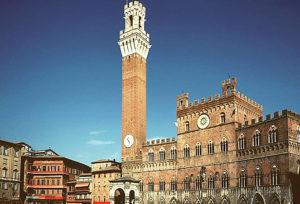 In the late Middle Ages, due to the new forms of government in cities of the Apenine peninsula, a new type of architecture emerges. This architecture implies town halls, mainly built in Gothic style. Town halls were meant mainly to show the city’s power and knowledge, so a lot of attention was given to their decorations as well. Their walls were painted in frescoes, and in them we find some novelties to the art of painting of the 14th century. It should be noted that, up until then, painting was mainly related to religious buildings, thus the themes of the paintings were also religion related. Themes that appear in these public buildings can be divided into several groups. Firstly, there are various displays of battles, both historical and contemporary. By them, the city showed its military strength. The second group comprised of various allegories and personifications, such as displays of seasons of the year, or works by months and signs of the Zodiac. However, this group also contains different representations of government, in which we find personifications of both virtues and flaws. There are also some religious images in town halls, such as frescoes of protector saints, or the Virgin Mary (for example Maesta by S. Martini in Palazzo Pubblico, Siena).
In the late Middle Ages, due to the new forms of government in cities of the Apenine peninsula, a new type of architecture emerges. This architecture implies town halls, mainly built in Gothic style. Town halls were meant mainly to show the city’s power and knowledge, so a lot of attention was given to their decorations as well. Their walls were painted in frescoes, and in them we find some novelties to the art of painting of the 14th century. It should be noted that, up until then, painting was mainly related to religious buildings, thus the themes of the paintings were also religion related. Themes that appear in these public buildings can be divided into several groups. Firstly, there are various displays of battles, both historical and contemporary. By them, the city showed its military strength. The second group comprised of various allegories and personifications, such as displays of seasons of the year, or works by months and signs of the Zodiac. However, this group also contains different representations of government, in which we find personifications of both virtues and flaws. There are also some religious images in town halls, such as frescoes of protector saints, or the Virgin Mary (for example Maesta by S. Martini in Palazzo Pubblico, Siena).
Sala delle Pace (Sala dei Nove)
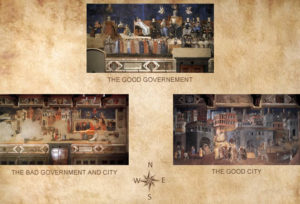 Here we shall review one of the most complex fresco cycles ever painted in a medieval town hall. It is located in the Siena Town Hall (Palazzo Pubblico), in a room called Sala delle Pace. The room was normally used for Councils of the Nine, who were in fact city governors, so this also had influence on the selection of the theme for the frescoes.1 The theme is good and bad city government, and their author is Ambrogio Lorenzetti. The work consists of three frescoes, each on its own wall. These frescoes are called Good Government (eastern wall), Good City (northern wall), and Bad Government and Bad City (western wall). The area of the southern wall is opened by a large window overlooking Siena and a part of the surrounding landscape.
Here we shall review one of the most complex fresco cycles ever painted in a medieval town hall. It is located in the Siena Town Hall (Palazzo Pubblico), in a room called Sala delle Pace. The room was normally used for Councils of the Nine, who were in fact city governors, so this also had influence on the selection of the theme for the frescoes.1 The theme is good and bad city government, and their author is Ambrogio Lorenzetti. The work consists of three frescoes, each on its own wall. These frescoes are called Good Government (eastern wall), Good City (northern wall), and Bad Government and Bad City (western wall). The area of the southern wall is opened by a large window overlooking Siena and a part of the surrounding landscape.
Good Government
 The display of Good Government is set up of several groups of characters. On the left side, there is a group of Justice, comprising of five characters. The middle represents Justice in its throne, and above it, there is Wisdom holding a scale. To its left and right sides there are two angels representing different types of justice. Two ropes descend over the scale, and join reaching the third character from this group, which is Harmony. This shows the main principles of good government of a city; wisdom and justice of the ruler, and harmony among the citizens. On the right side of the fresco there is a second group of characters. In the middle of it, there is a Ruler sitting on a throne wearing black and white, which represents colors of the crest of Siena. To his left and right there are six personifications of virtue, represented as: Peace, Bravery, Prudence, Generosity, Modesty and Justice. Thus, it represents virtues and principles needed for a good city government. Above the Ruler there are another three pendulous figures, representing theological virtues: Mercy, Faith and Hope. In the lower region, there is a procession consisting of 24 citizens of Siena, that represent the guardians of its Democratic government. Opposed to them, there is a group of guards with prisoners.
The display of Good Government is set up of several groups of characters. On the left side, there is a group of Justice, comprising of five characters. The middle represents Justice in its throne, and above it, there is Wisdom holding a scale. To its left and right sides there are two angels representing different types of justice. Two ropes descend over the scale, and join reaching the third character from this group, which is Harmony. This shows the main principles of good government of a city; wisdom and justice of the ruler, and harmony among the citizens. On the right side of the fresco there is a second group of characters. In the middle of it, there is a Ruler sitting on a throne wearing black and white, which represents colors of the crest of Siena. To his left and right there are six personifications of virtue, represented as: Peace, Bravery, Prudence, Generosity, Modesty and Justice. Thus, it represents virtues and principles needed for a good city government. Above the Ruler there are another three pendulous figures, representing theological virtues: Mercy, Faith and Hope. In the lower region, there is a procession consisting of 24 citizens of Siena, that represent the guardians of its Democratic government. Opposed to them, there is a group of guards with prisoners.
Good City
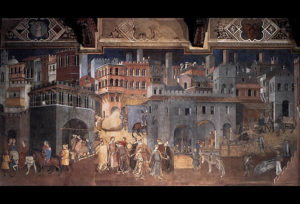 In the Good City we can see a panoramic view of a medieval city and its surroundings. The display itself, featuring a dome of a cathedral, black and white belfry, and buildings made of bricks, is much similar to Siena. Also, the fresco depicts all sorts of human activities within the city that are needed in order to have a well organized city. These include various manufactures, builders, and even leasure represented as dancing in the forefront of the fresco. On the right of the city, there is a panorama of a village, i.e. suburb. It depicts a series of human activities related to land and animal cultivation. Above the village there is a personification of Security, who holds a small gallows in one hand, and a scroll with text in another.
In the Good City we can see a panoramic view of a medieval city and its surroundings. The display itself, featuring a dome of a cathedral, black and white belfry, and buildings made of bricks, is much similar to Siena. Also, the fresco depicts all sorts of human activities within the city that are needed in order to have a well organized city. These include various manufactures, builders, and even leasure represented as dancing in the forefront of the fresco. On the right of the city, there is a panorama of a village, i.e. suburb. It depicts a series of human activities related to land and animal cultivation. Above the village there is a personification of Security, who holds a small gallows in one hand, and a scroll with text in another.
Bad Government and Bad City
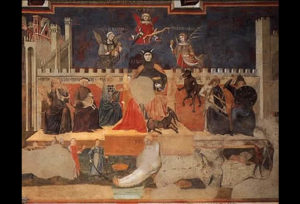 In Bad Government and Bad City the displays are a negative version of the ones on the northern and eastern walls. This fresco is in a bad condition, so its study is somewhat more difficult. It contains two parts: a display of personifications of bad city government, and various situations from bad city and village. On the right side, there are seven personifications of flaws and bad principles. In the middle there is Tiranny, with an exceptionally demonic appearance. It is bigger than the rest, because it is a negative version of the Ruler from the Good Government. Under its feet there is Justice, tied and with a broken scale. Other personifications from left to right are: Cruelty, Betrayal, Deception, Wrath, Disharmony and War. Above Tiranny we also find another three personifications: Conceit, Parsimony and Vainglory. In bad city and village there are depictions of people fighting, robbing, and the only person working is a blacksmith building a weapon. The village is uncultivated and infested, there are even houses on fire. On the same spot as Security on the eastern wall, here stands Fear, displayed as an old, skinny woman, threatening the village with a sword.
In Bad Government and Bad City the displays are a negative version of the ones on the northern and eastern walls. This fresco is in a bad condition, so its study is somewhat more difficult. It contains two parts: a display of personifications of bad city government, and various situations from bad city and village. On the right side, there are seven personifications of flaws and bad principles. In the middle there is Tiranny, with an exceptionally demonic appearance. It is bigger than the rest, because it is a negative version of the Ruler from the Good Government. Under its feet there is Justice, tied and with a broken scale. Other personifications from left to right are: Cruelty, Betrayal, Deception, Wrath, Disharmony and War. Above Tiranny we also find another three personifications: Conceit, Parsimony and Vainglory. In bad city and village there are depictions of people fighting, robbing, and the only person working is a blacksmith building a weapon. The village is uncultivated and infested, there are even houses on fire. On the same spot as Security on the eastern wall, here stands Fear, displayed as an old, skinny woman, threatening the village with a sword.
Medallions and Inscriptions
These grand displays have extensive frames with quadrifoiled medallions. They contain some other depictions that add to the primary ones. In upper frames are personifications of seven planets, their Zodiac signs, four seasons of the year and crests of Siena. The lower frames contain personifications of free arts, philosophy and tyrants from ancient time. The frescoes also contain numerous inscriptions, which complement the displays themselves. They were written in both latin and popular, Italian language.2
Meaning of Frescoes
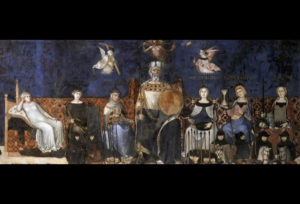 These frescoes have a very complex iconographical programme. It is considered that they were partially influenced by Aristotle’s texts, as well as local political texts, who’s authors had more contact with Roman writers.3 Although a similar depiction of the Ruler was described by G. Vasari in his writings on the lost frescoes of Giotto in Palazzo del Podesta (now Bargello) in Firenza, it is considered that those writings had no influence on the displays of A. Lorenzetti.4 An interesting fact, however, is that the displays are interrelated, and together form an edifying story of what is needed for a good government, and how a good government should look like.
These frescoes have a very complex iconographical programme. It is considered that they were partially influenced by Aristotle’s texts, as well as local political texts, who’s authors had more contact with Roman writers.3 Although a similar depiction of the Ruler was described by G. Vasari in his writings on the lost frescoes of Giotto in Palazzo del Podesta (now Bargello) in Firenza, it is considered that those writings had no influence on the displays of A. Lorenzetti.4 An interesting fact, however, is that the displays are interrelated, and together form an edifying story of what is needed for a good government, and how a good government should look like.
- One of few examples of secular painting in the late Middle Ages
- All displays in this room are interrelated and together form one common story
- Ed Norman, D. 1995. Siena, Forence and Padua: Art, Society and Religion 1280-1400, Volume II, Case Studies, London
- Wieruszowski, H. 1944. Art and the Comune int he Time of Dante, u: Speculum, Vol. 19, No. 1, 14-33
- Cecilia Janella…[et al.] 2003. I Protagonisti dell’Arte Italiana, Dal Gotico al Rinascimento, Firenca
- Tea Gudek, 2010. Sekularne teme u slikarstvu Trecenta (.pdf)
- 1 Ed. Norman, D. 1995. Siena, Florence and Padua: Art, Society and Religion 1280 – 1400, Volume II: Case Studies, London: 145
- 2 Ed. Norman, D. 1995: 155
- 3 Ed. Norman, D. 1995: 156
- 4 Ed. Norman, D. 1995: 157
Mi unisco a tutte le suddette. Cerchiamo di discutere la questione.
Very, very interesting. I´ll come and visit Sienna
It is the most magnificent and unprecedented mural in the world. it literally shows the judgment between good or bad, right or wrong in the light and shadow positions and the six personages are like adherents of the last judgement in the secular court for the unification of all the people.
I personally viewed these frescoes in June of 1983. They have haunted me ever since! Here it is 2012 and I’m still thinking about them!
Amazing! I’m doing a report on this topic.
These frescoes are called Good Government (eastern wall), Good City (northern wall), and Bad Government and Bad City (western wall).
Here I believe you have the passage slightly incorrect. You have the Good City in-between the Bad and Good Government frescoes.